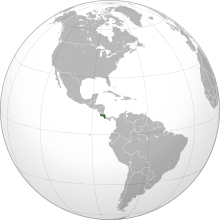Squatting in Costa Rica
Claimants, amongst them squatters, can present evidence to the court that they have been in continuous and open occupation for ten years and with the support of the neighbours they often gain title.
The following year, the Ley de poseedores en precario was intended to enable owners whose land in the Central Valley had been squatted to claim state-owned areas in replacement.
Squatting (and frontier colonisation in general) was criminalised in 1961, yet as the population grew in the 1960s and 1970s, the peasant land grabs increased both in number and scale, aided by urban students.
[1][5] The Osa Peninsula saw many occupations in the early 1970s as peasants took over 10,000 hectares until President Daniel Oduber Quirós created the Corcovado National Park.
In one dispute in Pavones, both a US rancher and a campesino (tenant farmer) were killed;[7] in another, a German plantation owner employed vigilantes who evicted squatters and then were disarmed by state forces.
